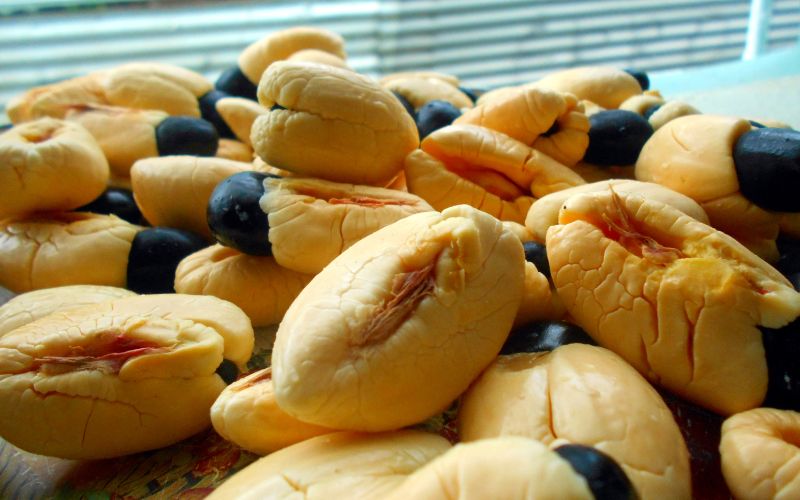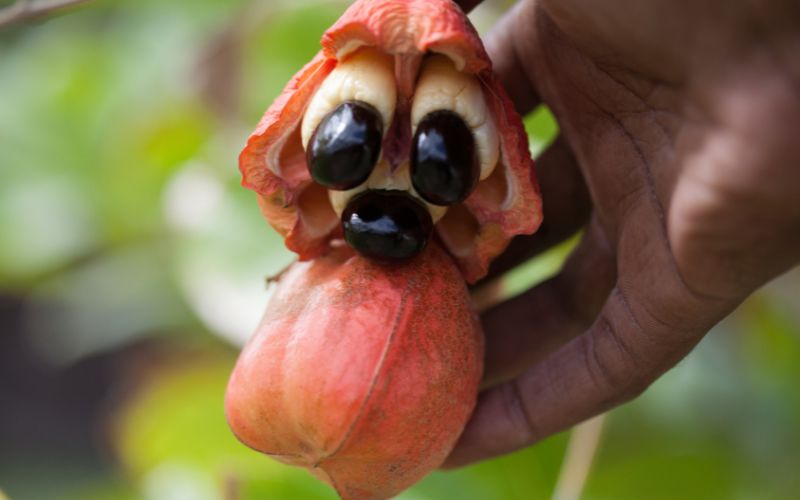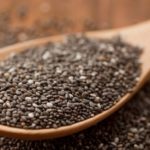The ackee fruit is an unusual-looking fruit that is a popular ingredient in many Caribbean dishes. However, this fruit contains toxins that are harmful to humans if consumed unripe. On the other hand, when cooked, it offers several health benefits. Let’s explore more about this fascinating fruit in the article below!
1 What is Ackee Fruit?
Ackee, with the scientific name Blighia sapida, belongs to the Sapindaceae family, which also includes lychee and longan. The ackee tree has a broad canopy and can grow up to 10 meters tall.
The fruit of this tree changes from green to bright red and then to yellow-orange when ripe. Interestingly, when the fruit splits open, it reveals large black seeds surrounded by soft, spongy, white or yellow arils.
This tree is commonly grown in tropical and subtropical climates, such as the Caribbean, and is particularly associated with the people of Jamaica. It is famously used in their national dish, salt fish and ackee.
 Ackee Fruit
Ackee Fruit
2 Nutritional Value of Ackee Fruit
Ackee fruit is a good source of dietary fiber, which is beneficial for digestive health, promoting healthy bowel movements and improving digestive health. Additionally, fiber helps reduce the risk of bloating, constipation, inflammatory bowel disease, and cramps.
This fruit is also rich in vitamin C, which helps improve iron absorption and reduce the risk of heart-related issues such as atherosclerosis and blood vessel damage. Furthermore, ackee fruit is a good source of iron, helping to improve anemia.
Ackee fruit also contains other essential nutrients such as calcium, potassium, magnesium, phosphorus, and beneficial fatty acids such as stearic acid, oleic acid, and linoleic acid.
 Nutritional Value of Ackee Fruit
Nutritional Value of Ackee Fruit
3 Is Eating Ackee Fruit Dangerous?
Despite its unassuming appearance, the ackee fruit contains a deadly toxin that can be fatal if consumed when unripe. This is because the fruit contains hypoglycin A, which can cause abdominal pain, vomiting, and hypoglycemia if ingested.
If the body absorbs too much hypoglycin A, it can overwhelm the digestive system, leading to increased vomiting, seizures, coma, and even death.
However, you can safely enjoy this fruit by cooking it, as the arils turn a beautiful butter-yellow color and have a strange yet appealing creamy taste. The people of Jamaica often cook this fruit with salted fish, creating a delicious dish.
 Is Eating Ackee Fruit Dangerous?
Is Eating Ackee Fruit Dangerous?
4 Precautions When Using Ackee Fruit
To ensure safe consumption of this fruit, keep in mind the following:
-
Eat ackee fruit only when it is fully ripe and the seeds have developed.
-
When preparing dishes, remove the seeds, peel, and any unripe fruits. Only consume the yellow or white arils.
-
Purchase the fruit from reputable sources to ensure its safety.
-
If you experience any symptoms after consuming this fruit, seek medical attention immediately.
 Precautions When Using Ackee Fruit
Precautions When Using Ackee Fruit
This article has provided some insights into the ackee fruit, including its unique characteristics and potential health benefits when consumed ripe. Remember to exercise caution and avoid eating unripe ackee fruit due to its toxic nature.




































